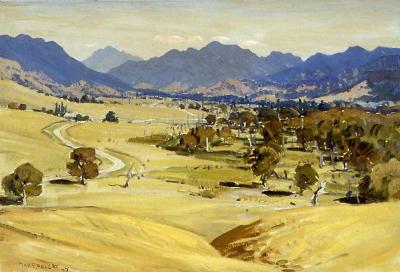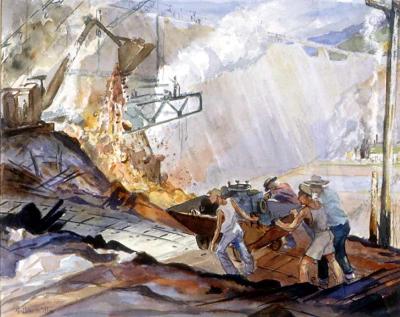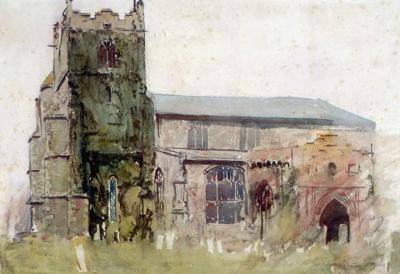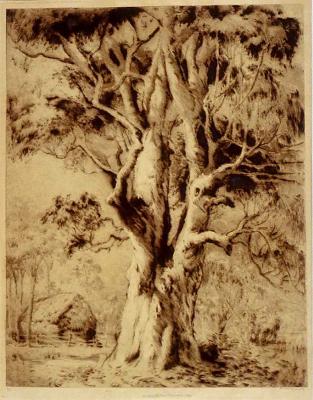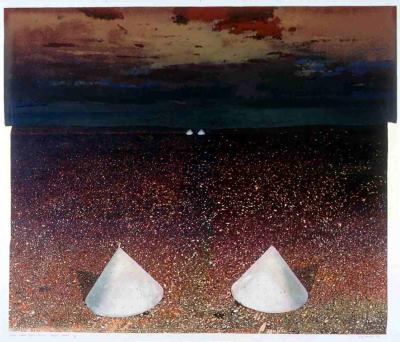Summer afternoon
Oil paint on canvas
This work was donated as part of the Claude Hotchin Bequest in 1958.
Details
Details
Signed lower right in brown oil paint 'H.S Power'
Harold Septimus Power (1877-1951), an artist, was born on December 31, 1877, in Dunedin, New Zealand, to Peter Power, a hatter born in England, and his Scottish wife, Jane, formerly Amers. After receiving some art training in Melbourne, he showcased his work in 1899 at the Melbourne Art Club, excelling in both animal and landscape categories. Subsequently, he relocated to Adelaide, where he served as an illustrator for various publications including the Observer, the Register, and the Critic. In 1904, he was commissioned by the trustees of the Art Gallery of South Australia to create an animal painting ('After the day's toil') for which he received 100 guineas. He married Isabel Laura Butterworth (d.1935) on September 17 of the same year.
From 1905 to 1907, Power studied at the Académie Julian in Paris before settling in London. There, he became a member of the Royal Institute of Painters in Oils and the Society of Animal Painters, exhibiting his work at esteemed venues such as the Royal Academy of Arts. His inaugural solo exhibition at the Guild Hall, Melbourne, in June 1913, featured oils and watercolors portraying rural landscapes, often serving as backgrounds for scenes of equestrian elegance and hunting, which captivated audiences and critics alike for the ensuing three decades.
In 1917, Power was appointed as an official war artist for the Australian Imperial Force, holding the honorary rank of lieutenant. His proficiency in animal painting was evident in works such as 'The First Divisional Artillery goes into action before Ypres July 31st 1917,' which garnered acclaim at the Royal Academy in 1919.
During the interwar period, Power alternated between Melbourne and overseas residences. His arrivals and departures were marked by notable exhibitions, typically featuring a Royal Academy masterpiece that garnered high praise. Even during the Depression, his paintings continued to sell well, with prices often reaching five hundred guineas. In 1927, he collaborated with W. B. McInnes on a commission to depict the ceremonial opening of the Federal parliament. Additionally, he completed various other commissions for both State and Federal entities, including a mural titled 'War' for the Public Library of Victoria (1924).
Power's achievements abroad rivaled those of his contemporaries, with exhibitions at prestigious venues such as the Royal Academy, the Royal Scottish Academy, the Royal Institute of Painters in Oils, the Royal Society of Portrait Painters, the Royal Water Colour Association, and the Paris Old Salon.
Advocates for traditional art in Australia during the interwar years lauded Power's work for its nostalgic depiction of rural life, reflecting the confidence, moral certainty, and self-absorption of the Edwardian era. Arthur Streeton praised Power's work, noting its vibrant colors and optimistic tone, along with his remarkable skill in portraying animals. Unlike some of his peers, Power did not need to adjust his artistic focus for different markets; his work resonated equally well both in Australia and abroad. In 1934, his solo exhibition in London received acclaim for its adherence to traditional artistic principles. At the height of his career, he was regarded as continuing a lineage from Landseer to Munnings. Following George Lambert's death in 1930, Power emerged as the preeminent equine artist in Australia. However, by the mid-1940s, his technical proficiency and choice of subject matter were viewed as outdated, criticized for sentimentality and commercialism.
Power passed away in Richmond, Melbourne, on January 3, 1951, and was laid to rest in Brighton Cemetery according to Presbyterian rites. He is survived by his second wife, Margery Isabel (née Desmazures), whom he married in Adelaide on September 5, 1936, as well as a son from each marriage. His works are widely displayed in major Australian galleries, and a significant exhibition in Sydney in 1985 sparked renewed interest in his works.


